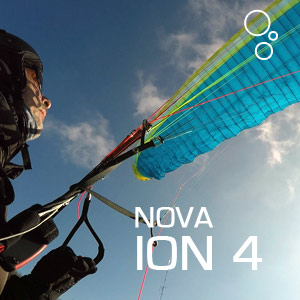
The Ion 4 is Nova's new entry level EN B glider. It's suitable for talented beginners, but most pilots will enjoy its superb performance to safety ratio. With its lightweight concept it should also be a hit with the Hike & Fly market and those who just want a lighter pack. It can be ordered with student risers or with a speedbrake riser (for XC pilots wanting to steer on the rear risers without affecting the camber and spoiling performance). Greg and Simon at Flybubble tested the Ion 4 out. Read their reviews here.
Nova ION 4 Review (Simon Steel)

I tested the Small which has a weight range of 80-100 kg. Nova say that the Ion 4 has more performance than the Mentor 3 and I reckon they might be right!
This is despite the fact that the Ion 4 has a slightly lower aspect ratio than the Mentor 3, a much lower projected aspect ratio (due to more arc) and a couple fewer cells (49 vs. 51).
It is very light with the Small size weighing in at 4.65 kg. This has been achieved by the beautiful engineering inside the wing cutting all the excess from the ribs and using less lines.
The wing has all the newest clever 3D shaping and uses different width cells to achieve refined tensions throughout the wing. The leading edge has the usual flexible rods but also a small amount of mylar in each cell. Nova says that you can pack the glider any way that you like, just not too tight for too long. (I think it's a good idea to pack a glider in slightly different ways to stop creasing it always on the same spots).
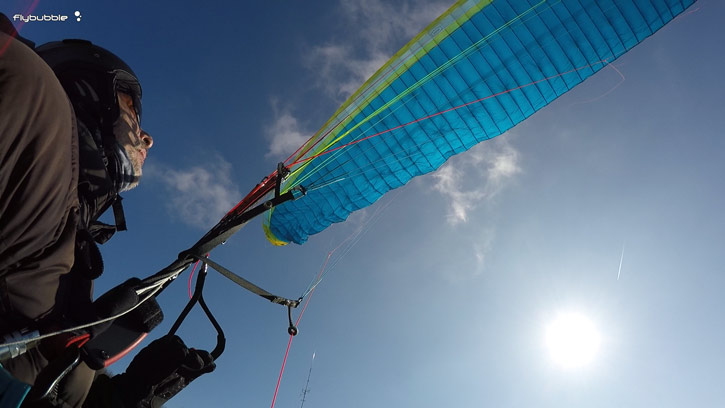
It's always nice to get a brand new glider out and this one feels light and silky. The line set was very easy to sort and I was soon clipped in. The wind was moderately strong and the glider wanted to fly but I had no problem holding it down on the rear (C) risers. Releasing the C's I leant back and without having to guide it up on the A's in the strong wind the wing came up smoothly in one block. In lighter winds a little help from the A's will launch you with no fuss. Forward launching is a easy too. I liked the high positioning of the brake poppers, they never rubbed on my hands, as some can.

In the air the glider is very solid and with its clever brake geometry and low aspect ratio the Ion 4 will turn very nicely using just the first part of the brake travel. After this the brakes get progressively more solid and I found to turn tight I needed to take a wrap so I was pulling and not pushing down on the brake so I had better control. Then it really whipped around! Great fun!
Big ears are easy to find with the split A's and the release is a non event as they slowly pop out.
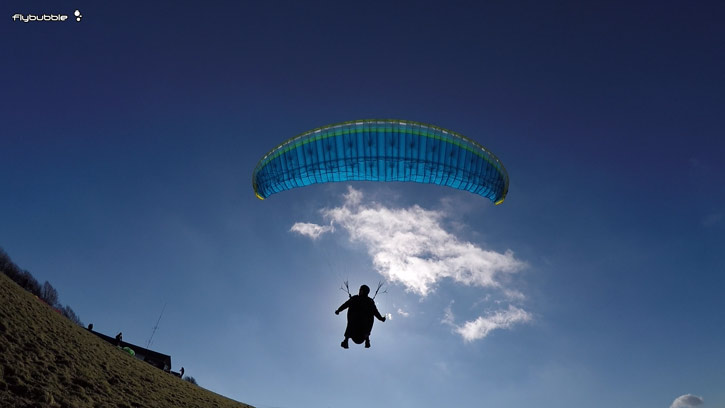
I tested the stall point by trying to top land in strong wind and 'mushed in', hovering for a while until a lull let me down but never felt too close to stall. The Ion 4 is a very forgiving wing and I think you'd have to be very heavy handed (and strong!) to stall it on landing. (Of course a bottom landing is an option, or just coming in from lower and turning in at the right moment).
Soon I had tested the groundhandling and was off to get some height and was very impressed with climb rate and performance of the Ion 4 against the other mostly higher rated wings in the air. Soon I was holding my own, coring tightly up, with the Ion 4 taking all the lumps and bumps out but leaving me with the 'pull' of the thermals and cores. Stress free flying! The speedbar is light and puts on a good turn of speed without the sink monster grabbing you. I found the rear risers were quite loose when on bar, I'd like to try the speedbrake as mentioned earlier to see how efficient it is.
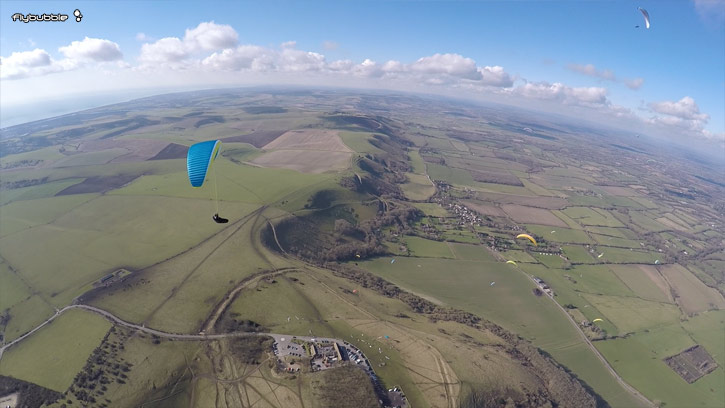
Summary
The Ion 4 will make a lot of pilots happy for differing reasons, be it the newish pilot looking for a solid wing with performance, someone looking for a more relaxing wing or the hike and flyer looking for a light weight, easy to land in a tight spot kind of wing!
Technical info
NOVA ION S (80-100kg) flown at 98kg
HARNESS FLOWN: Advance Lightness 2
TEST CONDITIONS: 2 hours in spring conditions, 2m/s thermals up to 2500ft, 10 degrees C, basewind 20km/h
TEST PILOT: tandem and XC pilot with over 1000 hours, flying since 1998. Currently flying Gin CARRERA+
Find out more about the Nova ION 4 >
Nova ION 4 Review (Greg Hamerton)
It's interesting to see how almost all modern wings (right down to the Progression Class) include some variation of the shark nose, especially the stepped intake aspect of it. The Ion 4 has an obvious step between the end of the leading edge and the start of the undersurface (Nova call it Air Scoop Technology), which improves the wing's tolerance for extreme angles of attack (slow flying and accelerated flying).
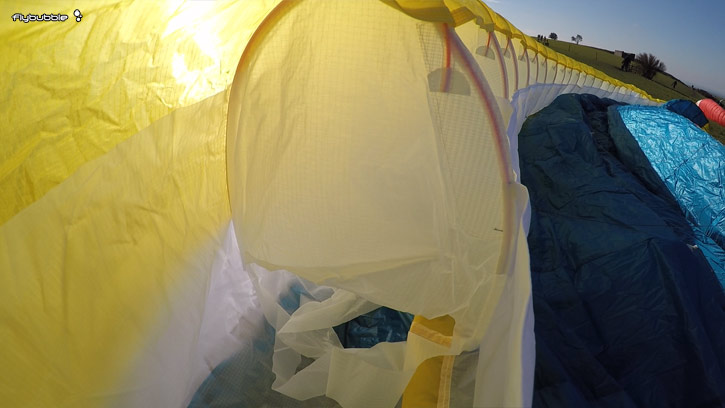
One noticeable benefit of this is that it fills quickly for forward launches. On the ground and in the air, it's steady, smooth, with a slightly utilitarian feel, meaning it does everything in an exact but functional way, with no 'life of its own', which is probably a good thing in this class. It's a very cohesive wing that doesn't flex or wobble as it flies.
It is possible to stall the wing with deep brakes and no wraps (at the seatboard) so it does require a few brain cells at least to fly it safely, and makes it a bit beyond what I'd be comfortable using as a training wing.
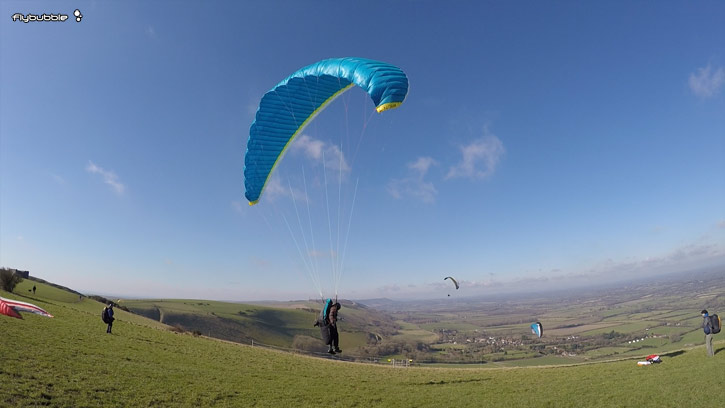
If you drag it down using the brakes, it stalls from 50 degrees or so, requiring As to re-energise the wing. It seems to resist dropping back slightly more than the Niviuk Hook 4, and as a design feature to help slow the launch down I'd say they've got it just about right here.
It overflies slightly if you pull up smoothly on the A's, so you'll need to use an occasional check-brake on steeper slopes. There's some slack in the brakes before they engage, with a noticeable knock of pressure.
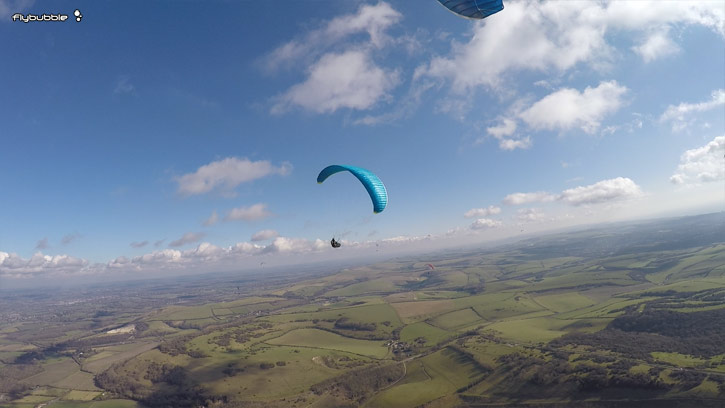
The turns are calm. Are they really smart brakes? Well, there's no adaptive ability or intelligence in them, they are just loops attached to the trailing edge, placed so they line up with the direction of force. It certainly doesn't feel any different to most wings I've flown, but there's no doubt the trailing edge is not as ragged as the Mentor 4, and the turn is smooth, steady and pressured.
If you turn hard, it goes into a spiral quite fast and builds up energy, again putting it beyond a schooling wing in my opinion, but it is suitable for a talented beginner and it certainly not too hot for the Progression Class. This may be due to the effective turn from the new brake system. It exits from the spiral fast and dampens energy well.
Using three pitch cycles (deep brakes, no brakes, repeat) there was no danger of front tucking, so it has good passive safety and ability to absorb pitch movements. There was no spin tendency I could notice. Big ears were stable, effective, and showed no stall tendency. Speedbar showed about 10kmh+ from trim speed (at low altitude and low loading).
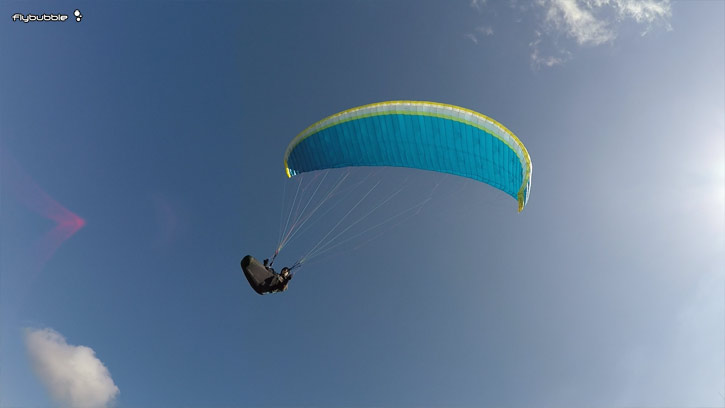
In their product video, Nova make a big thing of the safety of the Ion 4. I have no doubt it is well behaved in all EN tests. I think you can fly with complete confidence that the wing will help you out of trouble. That's the main benefit of choosing to stay in the Progression class and avoiding the temptation to chase performance in the XC class, which come with the added energy that requires intelligent management.
I would choose Nova's clever speedbrake riser option, because personally I find rear riser flying at speed useful and comfortable, although you're unlikely to need much in the way of pitch control on the Ion 4. Most pilots react faster on the rear risers than on locked-out legs, but hanging on the rear risers without the speedbrake system would result in deformation of the wing which isn't ideal.
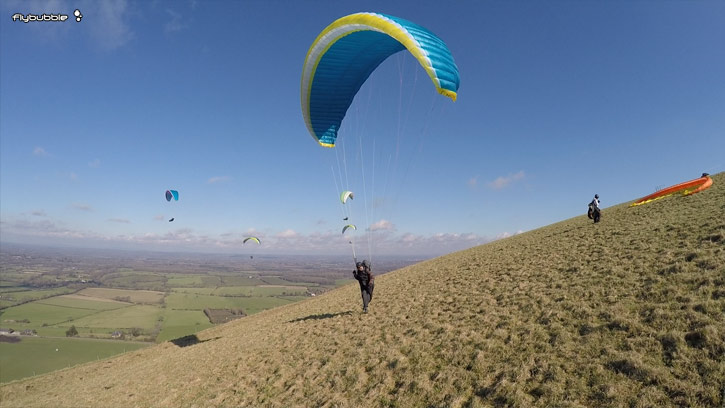
Summary
The Ion 4 is a well-designed evolution in the Nova range. It obviously performs well (Bernard Petzl flew 347km in Brazil). I expect it will frustrate many pilots on higher-classed wings with its ability to keep up. It is well behaved in all EN tests (certified EN B) and has a feeling of high passive safety. It is simple to fly and launch, and turns well, albeit with high pressure. It also looks good in the air. This Progression class wing is suited to pilots who have emerged from flying school with an eye on the horizon, eager to go places but needing a wing that will remain calm and centred. It also makes a nice hike-and-fly wing for more experienced pilots who want something that simply works while they are appreciating the scenery.
Find out more about the Nova Ion 4
Technical info
WING: ION 4 S (80-100kg) flown at 85kg
TEST CONDITIONS: 1 hour in mild thermic conditions on a ridge, 1m/s thermals to 1000ft, 11 deg, with 15km/h basewind
HARNESS USED: Skywalk Range XALPS
TEST PILOT: instructor with over 2500 hours, over 150 wings reviewed, flying since 1992. Currently flying Omega XALPS.
Nova ION 4 paraglider review video
Find out more about the Nova Ion 4
Brought to you by Flybubble
Want to see more? There’s no better way to support our efforts than buying from us. We’ll ensure you get great service! Choose from our great range AND enable us to produce more videos and articles to benefit the freeflight community.

